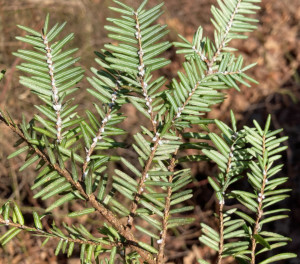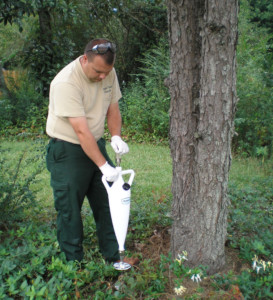
Waging War on the Hemlock Wooly Adelgid
By Brandon Merz, GFC Forest Health Specialist
It’s winter in Georgia, and while that means most forest pests are inactive, the hemlock woolly adelgid (HWA) is in its full feeding swing. This invasive pest has been killing hemlock trees in the Appalachian Mountains since its introduction to the US in the 1950s.
In past years, severe cold snaps like what we experienced at the end of December 2022, have resulted in HWA mortality at higher elevations in Georgia. While this provides a break for those trees, it unfortunately will likely not impact many landowners with infested hemlock trees in their yards. The best way a landowner can protect their hemlock trees from HWA is by applying a systemic insecticide via either a soil drench or soil injection treatment. These two treatments involve mixing the recommended amount of insecticide based on the diameter of the tree and applying it directly to the soil, either by pouring the mixture around the tree or by using an injector to dispense it into the soil. There are also imidacloprid pellets that can be buried around the base of a tree which don’t involve any mixing. Soil drench kits are available from UGA Extension Offices in several North Georgia counties, and soil injectors are available at GFC County Units within the hemlock’s native range. Both soil drench kits and soil injectors can be checked out with a rental deposit. A list of these offices can be found on the GFC’s webpage at: https://gatrees.org/forest-management-conservation/forest-health/soil-injector-loan-program-for-hemlock-woolly-adelgid/.

The two most common insecticides used are imidacloprid and dinotefuran. Imidacloprid is used on trees with light to moderate infestations. After application it will take up to three months to start seeing HWA mortality, but it will provide protection to the tree for five to seven years. Dinotefuran is used on heavy infestations because it is taken up quickly by the tree and HWA mortality will be seen in less than a month. However, it only provides protection to the tree for around two years. Detailed instructions on each of the soil treatments and insecticide application rates can be found on the GFC’s webpage https://gatrees.org/hemlock-woolly-adelgid-hwa-in-georgia/.
Winter is a good season to apply either of these insecticides with the soil treatments because it allows enough time for the hemlock tree to take up the chemical before the HWA’s summer aestivation (dormancy during a hot or dry periods). Don’t apply insecticides if the ground is frozen, excessively dry, or waterlogged. For these reasons, spring and fall make ideal treatment times as well. Remember to read the insecticide label and follow the application and safety instructions. Neither of the soil application methods should be applied within 10 feet of a stream channel, lake, pond, or wetland. Contact your local GFC forester for more information or if you have any questions.
